This is a Canon AF35M 35mm auto focus camera made by Canon in 1979. This camera was also known as the Sure Shot in the US and the Autoboy in Japan. It was the world’s first active auto focus camera. The Canon AF35M proved to be a pretty reliable camera that could handle most situations thrown at it. It had a sharp 4-element, semi-wide angle 38mm lens, a popup flash, motorized film advance, and was powered using regular AA batteries. The Canon AF35M helped set the standard for the design of a compact point and shoot camera and brought accurate auto focus and auto exposure to a whole new generation of photographers.
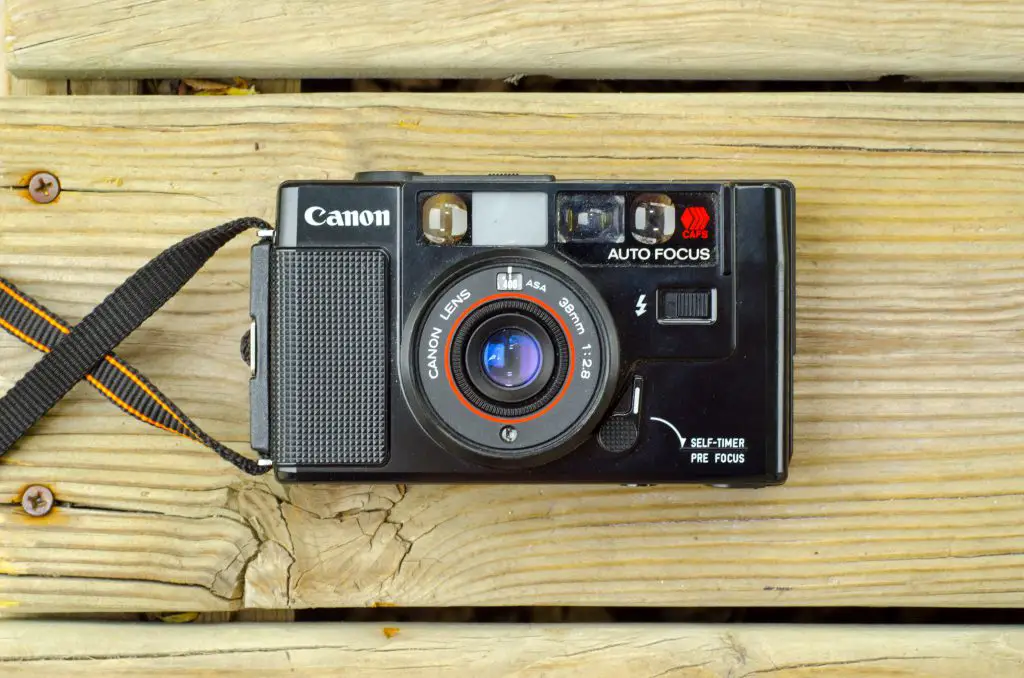 Film Type: 135 (35mm)
Film Type: 135 (35mm)
Lens: Canon 38mm f/2.8 Coated 4-elements
Focus: Near-Infrared Auto Focus
Shutter: Electronic Leaf
Speeds: 1/8 – 1/500 seconds, stepless
Exposure Meter: Full Program CdS meter
Battery: 2 x AA 1.5v Alkaline
Flash: Built-in Popup Electronic Flash
Weight: 405 grams (w/ batteries)
Manual: http://www.cameramanuals.org/canon_pdf/canon_af_35m.pdf
My Final WordHow these ratings work |
The Canon AF35M is a historically significant camera in that it had the world’s first active auto focus system. Canon clearly did something right with it because the camera was able to handle almost everything I threw at it. The auto exposure systems works incredibly well with or without the built in flash. The lens is razor sharp and shows a tremendous amount of detail and excellent color rendition. While it is frustrating to have absolutely no useful information in the viewfinder while shooting, I had no issues composing my images. This is a loud camera that doesn’t really look all that pretty, but in the end, it’s the results that count and that’s where this thing hits a home run. Considering how inexpensive these things are, it’s a perfect camera to keep in your car for spontaneous shots. I was really impressed with this camera and plan on using it again. | ||||||
| Images | Handling | Features | Viewfinder | Feel & Beauty | History | Age | |
| 2 | 1 | 1 | 1 | 0 | 2 | 0% | |
| Bonus | none | ||||||
| Final Score | 7.0 | ||||||
History
A funny thing starts to happen when word gets out that you are into “old cameras”. People come out of the woodwork to tell you of some film camera they found in a closet that used to belong to their dad, or inherited from their great aunt Edna after she passed away. These stories usually all start out the same. They’re usually mentioned off the cuff for fear that you might not be interested in their old junk, but of course when the conversation turns to “do you want it”, you never quite know what to say. Usually these people are friends, co-workers, or at least someone you have some sort of personal relationship with and you’re never quite sure what to offer them. They usually don’t come right out and say you can have it for free, but they never ask for money either. And of course they rarely know anything about what it could actually be. Dreams of Aunt Edna’s old Leica collection or perhaps a cache of old Mamiya wedding photographer equipment dance through our heads, but usually they end up being a plastic point and shoot APS camera from the 1990s.

In my case, the people were the parents of my best friend, and the camera turned out to be this Canon AF35M. In my journey collecting cameras, I had come across these before, but due to their modern, fully automatic list of features, I never considered one, but I was excited to see what it could do.
To say that the AF35M is a modern camera comes with a pretty big caveat. For one, this camera was first introduced in late 1979 making it almost as old as I am. This camera is older than several others in my collection like the Nikon FA or Canon AV-1, yet I consider it modern for it’s strong resemblance to a point and shoot camera.
The Canon AF35M is a historically significant camera, and when I took the time to hear it’s story and hold one in my hands, I began to appreciate it quite a bit more.
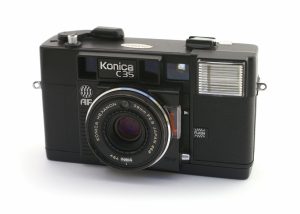
In terms of historical significance, the AF35M was the first camera in the world to offer a modern automatic focusing system. The reason I threw the word “modern” in that previous sentence is because it’s actually the second auto-focus camera released in the late 70s. The first was the Konica C35 AF which came out two years earlier in November 1977. Many people do not consider the Konica C35 AF to be a truly automatic focus camera because Konica “cheated” somewhat in how they accomplished automatic focus.
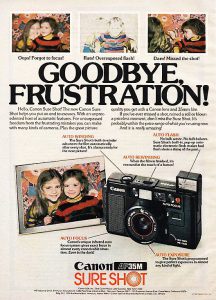
Konica employed the use of the Visitronic AF system that was created and produced by Honeywell. This system was a passive auto-focus design which used a traditional two window rangefinder to compare the light entering each window, and through the use of a primitive CPU, it would estimate range and then adjust the focus of the lens to achieve proper focus. Canon’s CAFS (Canon Auto Focus System) from the AF35M used a scanning infra-red light beam that would triangulate distance by reflected light bouncing back to the camera. Konica’s system was easily tricked and could not handle moving or very small objects very well. Canon’s CAFS system was far from fool-proof, but it handled a variety of scenes, including low light situations, much more reliably.
Whether you consider Konica’s passive, or Canon’s active systems to be the first truly automatic focus, they were still early examples of a technology that would become standard features on cameras half a decade later. In addition to defining what an auto-focus system could do, both the Konica C35 AF and the Canon AF35M set the standard for design of what a point and shoot camera would look like. At first glance, this camera doesn’t look a whole lot different than many cameras from 15-20 years later.
Edit (2/10/2020): I recently found a short review of Canon AF35M from the February 1980 issue of Modern Photography. In the article, author Lief Ericksenn compares the CAFS system to the Honeywell Visitronic system and comes away impressed. At the end of the article, he came away impressed with the camera, saying it’s a perfect “briefcase camera”.
In 1981, Canon would release a more advanced version of this camera called the AF35ML or the Super Sure Shot, which had a faster f/1.9 lens and a different auto focus system. This camera would be one of the only fixed lens auto focus cameras ever made with an f/1.9 lens. Then, in 1983, the AF35M II, or New Sure Shot would be released as a revised AF35M featuring the same 38mm f/2.8 lens, but in an all new body with a more prominent hand grip, quick load film system, and a few other minor tweaks.
My Thoughts
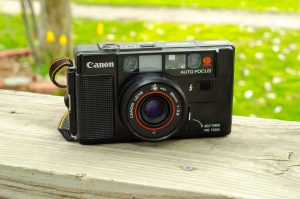
Upon closer inspection, the Canon AF35M is rather large. The body design resembles a plastic brick with mostly 90 degree corners and a size that would not fit into jean pockets or a small purse. Thankfully, the entire body is made of plastic, so the weight is kept to 405 grams including the batteries. The layout of the controls are pretty much exactly where you’d expect them to be. The overall design of the body is very similar to a rangefinder camera like the Canonet series. To someone not familiar with this model, the windows on the front of the camera could trick someone into thinking it actually had a rangefinder.
The lens is advertised as just a “Canon Lens” but is a 4 element design in 3 groups. It has a nice blue anti-reflective coating and the outer ring is threaded to accept standard 48mm filters, hoods, and auxiliary telephoto or wide angle lenses. The ability to accept filters and auxiliary lenses was a feature that was soon lost on most point and shoot cameras as the target customer would rarely have a need for this feature.
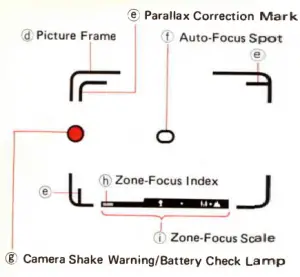 When looking through the viewfinder, there is no way to “see” focus. All focus operations are handled by the camera’s near infra-red CAFS sensor. There are projected frame lines for the 38mm focal length along with a second set of parallax lines for close focus, although this is not an automatic parallax correction. You just have to know which lines are correct.
When looking through the viewfinder, there is no way to “see” focus. All focus operations are handled by the camera’s near infra-red CAFS sensor. There are projected frame lines for the 38mm focal length along with a second set of parallax lines for close focus, although this is not an automatic parallax correction. You just have to know which lines are correct.
Also visible in the viewfinder is a rather unhelpful feature that Canon calls the “zone focus scale”. This scale goes from left to right across the bottom of the viewfinder. On the left of the scale is an icon of someone’s head to indicate close focus, then in the middle is a small group of people to indicate medium focus, and then on the far right is a grouping of trees to indicate infinity focus. A moving needle will move to the position that the camera has deemed is closest to accurate focus. The CAFS system is only engaged moments before firing the shutter, so there is no way to get a preview of which distance the camera will select without firing the shutter.
Another shortcoming of the CAFS system is that it can only detect what is in the center of the frame. There is a small oval in the center of the viewfinder to indicate the area in which the CAFS sensor will focus on. To combat this limitation, Canon implemented a strange feature in the self timer in which you can move it to a “Pre-Focus” position which activates the CAFS system without actually firing the shutter. To use this feature, you move the self timer lever all the way to the Pre-Focus position and then compose your image so that whatever you want in focus is in the center of the viewfinder and then press the shutter release all the way. This will actually begin the 10 second countdown for the self timer. You now have about 10 seconds to recompose the shot and either wait for the self-timer to expire, or press the shutter release a second time to fire it immediately while maintaining the original focus distance.
If you are interested in how early auto focus systems like CAFS worked, see this article from the December, 1980 issue of Popular Science. It goes into greater detail comparing how 4 different auto focus systems worked.
In practice, the CAFS system is clunky, and I could never get used to not really knowing if my images would be in focus. Comparing the Canon AF35M to a modern auto focus camera, you have to put a lot of faith in the camera to get it right as you have no way of knowing for sure. While it may seem limited by today’s standards, this really was a pretty groundbreaking system back in 1979.
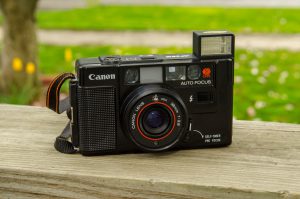
The rest of the camera works fairly predictably. It has a manually activated popup flash that is flash synchronized at all speeds. It can be used as either a fill flash in high contrast outdoor scenes, or as a regular flash up to about 5 meters in the dark. Upon pressing the shutter release half way, the camera’s built in photocell will alert you with a red LED in the viewfinder to indicate that either the flash is needed, or that you’ll need to stabilize the camera to prevent a blurred image. To use the flash, you must manually release it so that it pops into position at which point the flash will begin charging. The camera has a “flash ready” light on the back to indicate when the flash is fully charged. The recycling time for the flash is a painfully slow 8 seconds. The first time I tried to use the flash on mine, I actually thought it wasn’t working because it took so long to charge. I would have assumed the cheap alkaline batteries I was using were causing the flash to be so slow, but the AF35M manual confirms the 8 second recycling time.
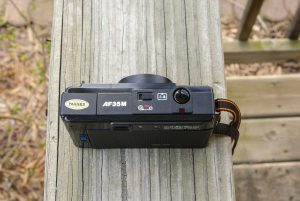
Speaking of batteries, the camera uses two regular AA 1.5v alkaline batteries. The manual specifically states that NiCd batteries should not be used, although I am sure modern NiMH batteries (which didn’t exist in 1979) would probably work fine. The batteries load via a plastic flap on the bottom of the camera. The flap feels rather flimsy, but thankfully showed no signs of failure. I would guess that at least a certain percentage of these cameras would have broken battery compartment doors after all of these years.
The camera has a motorized film advance and rewind, although strangely when reaching the end of the roll of film, you must still press a release button on the bottom of the camera like an old school manual camera, and then activate the rewind motor via a switch on the top plate. It will not automatically rewind the film upon reaching the end of the spool.
All of the motorized functions of this camera like the focus motor, the film advance, and the rewind are loud. This camera came out at a time when automation in cameras was pretty new, so either the camera makers just didn’t know how to make things quiet, or they just assumed no one would care. The noises this camera make basically negate any chance at being discreet. Anyone in a 20 foot radius will hear the camera any time you take a photograph. If you read through many of the reviews linked below in the Additional Resources section, you’ll hear the same complaint about the noise levels of this camera in almost every review.
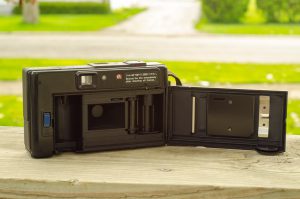
Loading film into the camera is relatively simple, although not quite as automatic as those with a Quick Load feature. You still need to thread the film leader into the take up spool, and upon closing the film door, you need to press the shutter release a couple of times to advance the film to frame 0. The Canon AF35M does not automatically advance a new roll of film for you. It also cannot read the DX encoding on the film cassette. You must set the film speed manually via a plastic ring around the lens of the camera. The AF35M supports film speeds from ASA 25 – 400. There is a film transport indicator on the back of the camera which will “jiggle” when film is properly loaded.
Once you have film loaded into the camera and have advanced it to frame 0, you are ready to go shooting. Here is where things got interesting. While out shooting with the AF35M I really had no idea if the camera was working properly. Sure, it made a bunch of noises, and the flash seemed to work, but with no real way of knowing if anything was in focus, or what aperture or shutter speed the camera was selecting, you really have to just throw caution to the wind and hope for the best. Even though I have a lot of experience shooting film, it’s still a challenge to wrap my head around the fact that you have absolutely no information whatsoever about what the camera is doing. This is definitely not a camera for someone with OCD or control issues!
My Results
After finishing my roll and sending it off to the lab for processing, I was on pins and needles waiting to get my scans back. As I said before, the Canon AF35M gives you no information about the focus, aperture, or shutter speed while shooting, you just have to hope for the best.
I should also mention that I developed the roll of film from this camera at the exact same time as a roll from the Konica AiBORG. The AiBORG is a modern auto focus camera from 1991. The Canon AF35M is about 12 years older than that AiBORG, and you’d think that in the decade or so time that had passed between the two models, that the newer camera should have had an edge. I don’t want to spoil anything for you, but if you’re interested, check out my review for the Konica AiBORG and see how two different auto focus cameras compare.
I was extremely pleased with the results from the AF35M. The CAFS system worked perfectly in all but 2 shots. Strangely, a relatively simple head shot of a baby came out blurry, but almost every other shot was perfectly in focus. The accurate focus highlights the sharpness of the 4-element 38mm Canon lens. The picture of the tree shows tremendous detail in the bark. Colors in all of these shots are bright and cheerful. It is clear that in the early days of point and shoot cameras, companies like Canon still put some high quality glass in them.
I was also impressed with the auto exposure system. I tried to trick the camera by shooting outdoors in bright sunlight both with the fill flash on and off. The last two shots above are with the flash on and the scene is nicely balanced without blown out highlights or a muddy background. The two interior shots above also look great. There is still some detail in the background without making it look like the subject is standing in front a black wall of darkness. After seeing the quality of shots from this camera, I don’t know if I could have done any better with any of my Canon SLRs with “better” lenses.
The Canon AF35M might not reveal any useful information while shooting, but apparently it doesn’t need to. Although I’ve shot only one roll, during research for this article I read several other reviews online, and found that most people had positive results similar to mine. It would appear that this plastic brick of a camera is actually pretty great. This might be the perfect “travel” camera for throwing in a bag or in your car. It uses regular AA batteries, so if they die while out shooting, you can replace them anywhere without needing to worry about a charger or silver-oxide replacements. It’s also very easy to use so for those of you like me who have a wife or friends who don’t have the same level of interest in film, you can hand this to them and not have to spend any time explaining how to use it. They should get just as great of shots from this camera as you can.
Related Posts You Might Enjoy
External Links
https://en.wikipedia.org/wiki/Canon_AF35M
http://camera-wiki.org/wiki/Canon_AF35M
https://www.lomography.com/magazine/220961-canon-af35m-the-absolute-automation-of-the-autoboy
http://www.canon.com/c-museum/en/product/film102.html
https://www.casualphotophile.com/2015/02/23/canon-af35m-vs-nikon-l35af-camera-review/
http://www.d2gallery.com/camera-canon_af35m.php
http://randomphoto.blogspot.com/2010/09/canon-in-minor-af35m.html
http://christophergriffiths.weebly.com/blog/canon-af35m-ii-autoboy-2-sure-shot-review
https://www.flickr.com/photos/greyscale3/sets/72157625620358948/

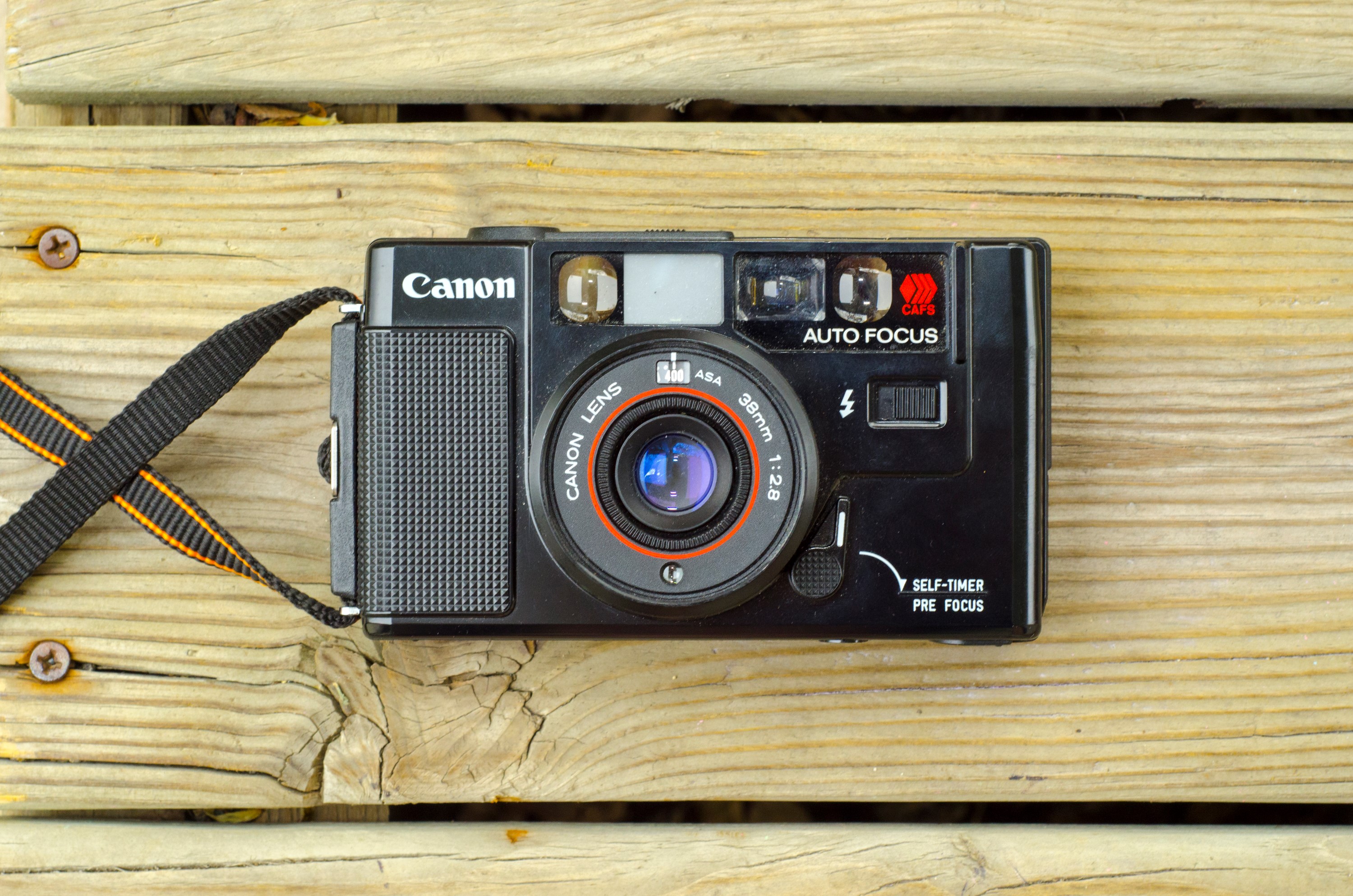
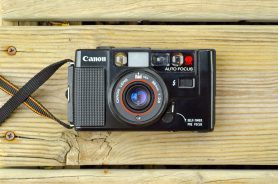
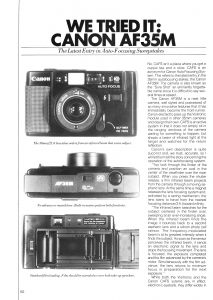
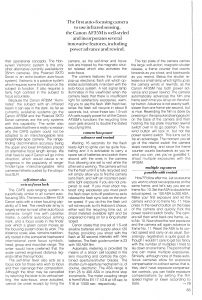









great review, mike. i just got one of these little guys a few months ago — my first film camera after shooting digital for years — and i am liking it so far. it is very retro and the loud noises it makes are kind of funny. i found your blog because i didn’t immediately rewind the film and now it won’t rewind. have you had that problem?
Thanks for the compliments and welcome back to the wonderful world of film! Although the AF35M lacks the “prestige” of more popular models, it is still capable of extremely sharp shots!
If you are having trouble rewinding the film, the only thing I can think of is that you have to press the rewind release button on the bottom of the camera before attempting to rewind it. On some models, you need to press and hold the release button throughout the entire duration of film rewind. If that doesn’t work, Im sorry, but I have no other suggestions. Your camera might simply need to be repaired. Good luck!
i took it to the place where i buy my film and they helped me. the battery was just dead. apparently, if you don’t immediately rewind, the camera keeps on using up the battery, and so my batteries were dead. they put in new batteries and i was able to rewind!
The Canon AF35M was my first autofocus camera, which I’d gotten for my mother, since it seemed to be the ideal “press the shutter and the camera does the rest” unit. It worked a lot better than the 110 Voigtlander fixed focus camera. (I should have remembered that one has to have focus control, since “fixed focus” is actually “no-focus.” That was the object lesson from a Minolta 16II subminiature, pre-110 camera.)
The camera could be tricked by window glass, so one had to take an “at-an-angle” approach to eyeglasses, etc. In time, I wondered about autofocus 35mm SLR cameras, but stayed off the “Maxxum train.”
My first autofocus 35mm SLR camera was a Canon EOS 650, which was followed by a “semi-pro” EOS 620. Nikon’s autofocus SLRs didn’t appeal to me, so I stuck with Ye Olde Nikon F2 and FM-2, since they were used for “Lab work” that didn’t require new-fangled tech. This held until I saw a Nikon D40 outfit at a Radio Shack store, and “took the plunge” to see what was up with digital photography. (But that’s another story.)
Patrick, thank you once again for such a detailed reflection on your history with this model. I always enjoy seeing your comments on my reviews as you have a lot of great experience with many of these old cameras! Keep ’em coming!
Great evaluation, I wonder if the images were edited ? The colors appear a bit strong and the image is quite sharper than what we see on other sites. Also, would be good to shoot other compositions that ones with bright colors – so we can see how the camera performs with less ‘flashy’ subjects.
This is one of my older reviews, from 2016 before I developed and scanned my own film. These shots would have been done by a lab, so it’s very possible some level of post processing was done, I can’t be sure though. Whether or not the colors were manipulated, you can still see that the lens is very sharp and exposure spot on.
I came into possession of a pair of DeJur auxiliary lenses without any instructions. The lenses are marked “For AF35M-II” which led me to this post. Searching on eBay, I can see lots of copies of them for cheap. I assume there’s no other AF35M-II and they’re for the camera in this post. Might be a fun accessory for a more advanced photographer such as yourself!